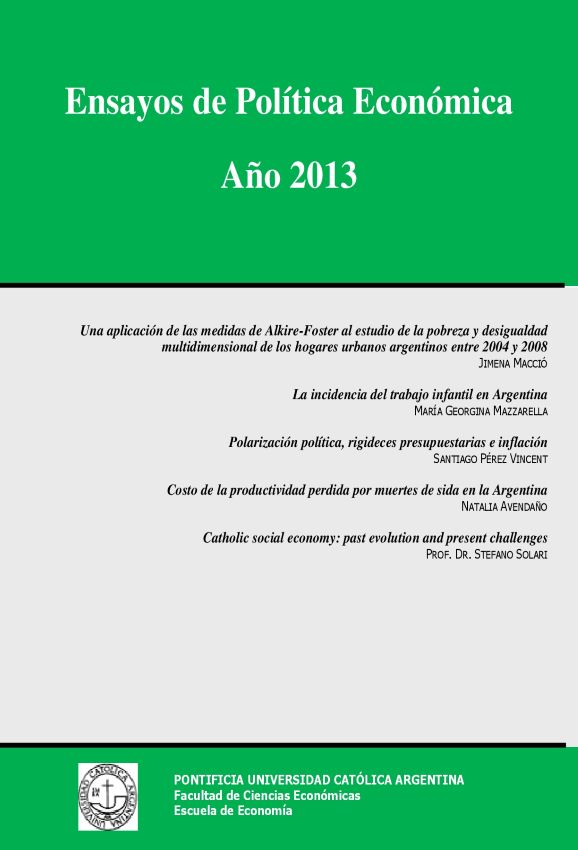Political polarization, budgetary rigidities and inflation
Keywords:
inflation, political economy, budget, public spendingAbstract
Inflation performance differs substantially across countries. The characteristics of the political system are considered as important determinants of inflation outcome by economic literature. In particular, political instability and political polarization are associated with higher inflation rates and volatility. This paper provides an alternative explanation for this documented relationship. The paper shows that public budget rigidities (specially, downside nominal inflexibility in public expenses) combined with high political polarization can create incentives leading to higher inflation rates and higher inflation volatility.
Downloads
References
Aisen, A. y Veiga, F. (2005). “Does Political Instability Lead to Higher Inflation? A Panel Data Analysis”. IMF Working Paper. WP/05/49.
Aisen, A. y Veiga, F. (2008a). “Political Instability and Inflation Volatility”. Public Choice. Vol. 135, N 3-4. Págs. 207-223.
Aisen, A. y Veiga, F. (2008b). “The Political Economy of Seigniorage”. Journal of Development Economics. Vol. 87. Págs. 29-50.
Alesina, A. (1988). “Macroeconomics and Politics”. NBER Macroeconomic Annual 1988. Págs. 11-55.
Alesina, A. y Sachs. J. (1988). “Political Parties and the Business Cycle in the United States, 1948-1984”. Journal of Money, Credit and Banking. Vol. 20, N1. Págs. 63-82.
Calderón, C. y Schmidt-Hebbel, K. (2008). “What Drives Inflation in the World?”. Banco Central de Chile. Documento de Trabajo N491.
Campillo, M. y Miron, J. (1997). “Why Does Inflation Differ across Countries?”. Capítulo en: Romer, C. y Romer, D. “Reducing Inflation: Motivation and Strategy.” University of Chicago Press.
Cetrángolo, O., Jiménez, J. y Ruiz del Castillo, R. (2010). “Rigidities and Fiscal Space in Latin America: A Comparative Case Study”. CEPAL. Serie Macroeconómica del Desarrollo N 97.
Cotarelli, C., M. Griffiths and R. Moghadam. (1998). “The Non-Monetary
Determinants of Inflation: A Panel Data Study”. IMF Working Paper. WP/98/23.
Cukierman, A., Edwards, S. y Tabellini, G. (1992). “Seigniorage and Political Instability”. The American Economic Review. Vol. 82, N 3. Págs. 537-555.
Edwards, S. (1993). “The Political Economy of Inflation and Stabilization in Developing Countries”. National Bureau of Economic Research. Working Paper N 4319.
Edward, S. y Tabellini, G. (1991). “The Political Economy of Fiscal Policy and Inflation in Developing Countries: An Empirical Analysis”. Policy Research Working Paper Series N 703.
Etcheverry, J., Bonilla, J. y Moya, A. (2006). “Rigideces Institucionales y Flexibilidad Presupuestaria: los Casos de Argentina, Colombia, México y Perú”. Universidad de los Andes. Documento CEDE 2006-33.
Heymann, D. y Sanguinetti, P. (1994). “Fiscal Inconsistencies and High Inflation”. Journal of Development Economics. Vol. 43, N1. Págs. 85-104.
Hibbs, D. A. (1977). “Political Parties and Macroeconomic Policy”. American Political Science Review. Vol. 71, N4. Págs. 467-497.
Ize, A. y Ortiz, G. (1987). “Fiscal Rigidities, Public Debt, and Capital Flight”. IMF Staff Papers. Vol. 34, N 2. Págs. 311-332.
Nordhaus, W. (1975). “The Political Business Cycle”. Review of Economic Studies. Vol. 42, N2. Págs. 169-190.
Ozler, S. y Roubini, N. (1996), “Economic and Political Determinants of Inflation Rates: An Empirical Investigation Using a Data Panel Set”. Working Paper N 199. Center for Institutional Reform and the Informal Sector. University of Maryland.
Paldam, M. (1987). “Inflation and Political Instability in Eight Latin American Countries 1946-83”. Public Choice. Vol. 52, N 2.
Persson, T., y Tabellini, G. (1990). “Macroeconomic Policy, Credibility and Politics”. Fundamentals of Pure and Applied Economics. Vol. 38 Macroeconomic Theory Section.
Pettersson-Lidbom, P. (2007). Do Parties Matter for Economic Outcomes? A Regression-Discontinuity Approach. Mimeo. Stockholm University.
Rogoff, K. y Sibert, A. (1988). “Elections and Macroeconomic Policy Cycles”. Review of Economic Studies. Vol. 55, N1. Págs. 1-16.
Spiller, P. y Tommasi, M. (2000). “El funcionamiento de las instituciones políticas y las políticas públicas en la Argentina: una aproximación desde la nueva economía institucional”. Desarrollo Económico. Vol. 40, N 159. Págs. 425-464.
Tommasi, M. (1998). “Instituciones y resultados fiscales”. Desarrollo Económico. Vol. 38, N 149. Págs. 409-438.
Downloads
Published
How to Cite
Issue
Section
License







 Ensayos de Política Económica
Ensayos de Política Económica